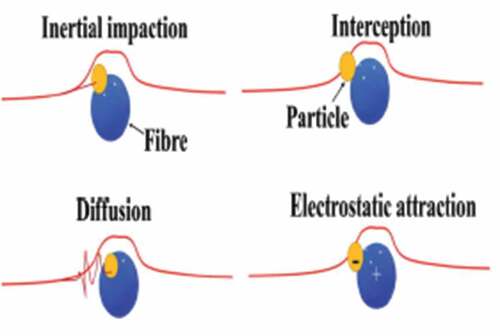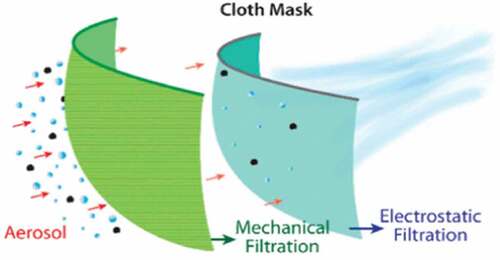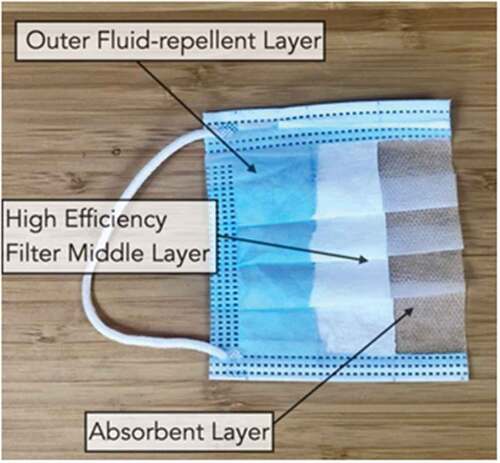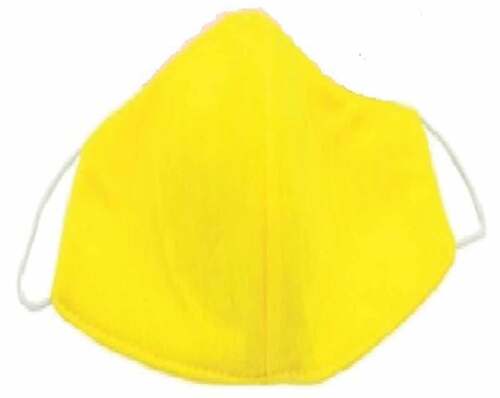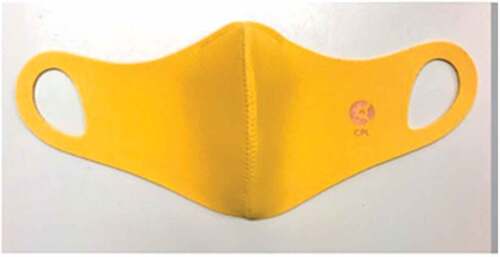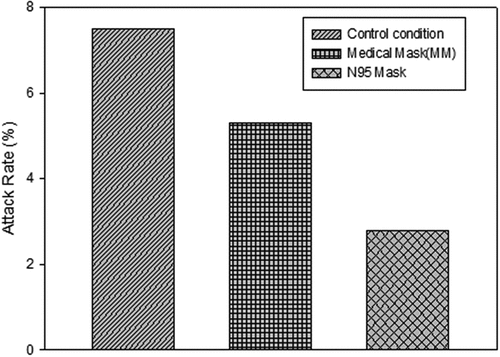 ?Mathematical formulae have been encoded as MathML and are displayed in this HTML version using MathJax in order to improve their display. Uncheck the box to turn MathJax off. This feature requires Javascript. Click on a formula to zoom.
?Mathematical formulae have been encoded as MathML and are displayed in this HTML version using MathJax in order to improve their display. Uncheck the box to turn MathJax off. This feature requires Javascript. Click on a formula to zoom.ABSTRACT
Community-wide mask wearing may contribute to the control of COVID-19 by reducing the amount of emission of infected saliva and respiratory droplets from individuals with subclinical or mild COVID-19. In this work, a brief review is presented on face masks and related things. First, the size of microorganisms in relation to PM2.5 and PM10 is given for an approximate estimate of the sizes of objects that needs to be filtered. In continuation, the principles of filtration of objects by the network of fibers (woven, non-woven, knitted, etc.) are given. Common fibers used for making face mask is presented along with various fabric structure and their manufacturing. Additionally, advancements like the treatment of fibers in terms of coated fabrics, nano-particle finishes, and green synthesized nano-particle coatings have been explained in view of their anti-bacterial and anti-viral properties. The classification of the face masks based on their fabric make-up has been given which has been extended to classification based on the barrier properties and various efficiencies of the face masks. The characterization of face masks like particle filtration efficiency, bacterial filtration efficiency, breathing resistance, flash resistance, and flame resistance are also included.
摘要
佩戴社区口罩可以减少亚临床或轻度新冠肺炎患者感染唾液和呼吸道飞沫的排放量,从而有助于控制新冠肺炎. 在这项工作中,对口罩和相关事物进行了简要回顾. 首先,给出了与PM2.5和PM10相关的微生物的大小,以粗略估计需要过滤的物体的大小. 接着,给出了通过纤维网络(编织、无纺、针织等)过滤物体的原理. 介绍了用于制作面罩的常见纤维以及各种织物结构和制造方法. 此外,从抗菌和抗病毒性能的角度解释了涂层织物、纳米颗粒饰面和绿色合成纳米颗粒涂层方面的纤维处理等进展. 已经给出了基于其织物组成的面罩的分类,该分类已经扩展到基于面罩的屏障特性和各种效率的分类. 口罩的特性,如颗粒过滤效率、细菌过滤效率、呼吸阻力、耐闪光性和阻燃性也包括在内
Introduction
The health care workers are the front runners to save the people from communicable disease transmission and the face mask plays a vital role to protect them from various hazardous conditions (Chellamani and Thiruppathi Citation2009). The face mask has important requirements for each application and usage. There are different types of face masks available for different application. Broadly, the facemask for the protection against particulate and against gas by the use of the adsorbent is two main types. The protection against the dust particles, bacteria, and viruses comes under the particulate protection category based on the size of the particulate. It is to be elaborately analyzed for understanding the characteristics of various face masks that can be used in pandemic situation for the protection against the viruses. The face mask is mainly required to cover the mouth and nose of wearer, where the contaminated secretion is prone to discharge (Hayavadana and Vanitha Citation2009). The face mask filters the bacteria or microorganism in the form of aerosol or liquid droplets that possibly discharge from the mouth and nasopharynx of human. It helps to prevent the transmission of infection from an infected person to others. Various studies confirmed that large numbers of bacteria that causes a communicable disease could be stopped by using proper face shield or mask (Hofmeyr et al. Citation2008). The studies also encouraged to use different layers of masks to prevent the spreading of communicable disease. The two layered surgical mask may be found suitable as compared with single layer mask for surgery in earlier days. It may prevent the spreading of infections between 1–3 feet (Belkin Citation2009; Doust and Lyon Citation1918). Other study confirms that the face mask also prevents the splashing of bloods and other fluids from communicable organs (Woodhead et al. Citation2002).
From earlier days to modern era, the face mask is mainly used in two different forms. It can be distinct as a surgical mask and respirator. Surgical mask mainly helps to support the patients by providing protection from germs and respirator is mainly used to shield the wearer from any hazardous environment (Wilson Citation2020). With the advancement in the material science and with the demand as per the situation, recently, large amount of development have been taken place in the improvement of the face mask efficiency at the optimum pressure drop.
During long time wearing of mask, the wearer feels warm and humid inside of the mask due to the breathing and saliva creation which could be a suitable condition for the intercepted microorganism to grow and flourish. The microorganisms will aggregate as an extracellular polymeric matrix that contains polysaccharides, proteins, and deoxyribonucleic acid (DNA) that may result in the formation of biofilm. In the situation of coughing or sneezing, an unexpected danger arises due to the reaerosolisation of the settled particles, so the facemasks are required to be discarded after a single use to avoid an inoculation and spread of highly infectious pathogens. The single use masks may lead to massive shortage due to high demand during the pandemic situations, and there are challenges in disposal of such mask since they are produced from synthetic polymeric materials, so the environment calls for reusable masks in the markets. The surface coated antimicrobial masks are effective in deactivating or killing the microorganisms and also they are preventing the growth of the biofilms, as well as interaction of the antimicrobial agents with microorganism (Gayathri et al. Citation2021).
The function of a face mask can be understood by analyzing the following factors such as face mask construction, structure, manufacturing, characterization, and classification and it has been comprehensively reviewed in this work. The face mask can be arranged as single to multiple layers with woven, non-woven, and knitted structures (fabrics) by various manufacturing techniques. The chemical treatment such as coating the fabric with various chemicals and nanomaterials may also provide good efficacy to the face mask. The manufactured face mask can be evaluated by bacterial and particulate filtration efficiency, breathing, flame, and splash resistance. In this paper, a comparative study on the various face mask efficiency and the recent advancement is also discussed.
The Sizes of the Microorganisms
There is a difference in the sizes of the different microorganisms, bacterias, and viruses which are been compared with the particulate size (). The size of the smallest bacteria is about 0.4 micron and the size of the viruses is ranges from 0.02 to 0.25 micron. Even some of the viruses are very small in size viz. the parvovirus and the zika virus have sizes around 20 to 40 nm. Some viruses of large size are around 3 micron. On the other hand the particulate matter can be of size 0.007 micron, however, SARS-CoV-2 virus is of size 0.1 micron (Sotirio Citation2020). The face mask is very much effective for the removal of conventional viruses which are of size around 2 to 3 micron but for viruses of very small size as SARS-CoV-2 virus, more effort is required to design the mask with the appropriate filtered layer selection.
Figure 1. Sizes of different types of microorganisms, bacterias, and viruses along with PM2.5 and PM10 particles.
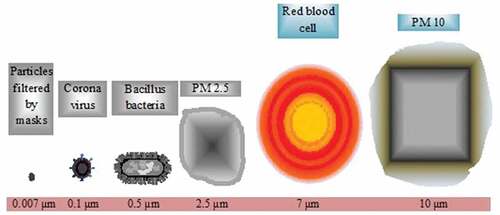
Most respiratory infections are transmitted by large respiratory droplets, larger than 5 μm, produced by coughing and sneezing, and then deposited onto exposed fomite or mucosal surfaces () (Gayathri et al. Citation2021). Airborne transmission has often been attributed to infectious droplet nuclei produced by the dryness of suspended droplets and defined as 5 μm or smaller in size, normally the plumes of aerosols are generated by sneezing or coughing. During sneezing the group of pathogens coming out from our nose or mouth with body fluid will suspend in the air. This has been believed to happen only for tuberculosis and a few other pathogens, so surgical masks have been recommended for use against most respiratory infections (Fennelly Citation2020).
Figure 2. A photograph of particle distribution caused by human-being from mouth secretion through a) sneezing and b) cough (Gayathri et al. Citation2021).
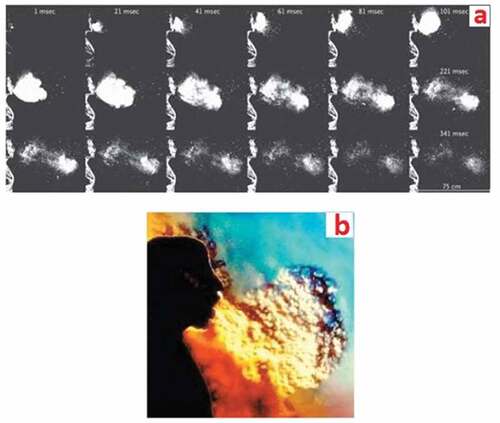
Principles of the Filtration by Fibrous Network
The filtration is an important process to understand the efficacy of the mask and it is possible with the following filtration mechanism in textile fiber. For instance, particles greater than 0.6 micron in diameter may be filtered out by the process of inertial impaction and interception. Inertial impaction occurs when the heavy particles face difficulties in flowing along the air streamline because of the heavy mass and inertia, and the particles suddenly collide with the fiber. On the other hand, interception is the mechanism to deposit big particles which may follow the streamline of air and it provides enough support to contact the filtration surface of the fiber. However, the above mechanisms have less impact on the particles smaller than 0.1 micron such as SARS-CoV-2. Hence, the mechanisms like diffusion as well as electrostatic deposition play a vital role in such a small particle deposition. The random Brownian movement of air molecules causes the collision along the small particles and pulls across the streamlines of air until contacting the surface of filtering fibers where the fiber stops the movement of particles by electrostatic attraction (3M Science Citation2020a; Shah and Rawal Citation2016).
The particle size >20 µm can be separated by gravity sedimentation, however, the medium sized particles (>1 µm to 10 µm) will be separated by inertial impaction and gravity sedimentation. If the particle sizes are 0.1 to 1 µm, the interception principle will be most appropriate. In diffusion or Brownian movement, particles are deviated from the flow streamline and randomly diffuse through the filtration medium for particles smaller than 1 µm. The particles below 0.2 µm are mainly captured by masks that utilize electrostatic interaction based filtration mechanism. The representation image shows the filtration of the particles in (Ebuka, Zakey, and Escobar Citation2021; Gayathri et al. Citation2021; Song, Mandal, and Rossi Citation2017).
Filtration efficiency is the percentage of particles of a certain size that would be stopped and retained by a filter medium and breathability is the ability of a fabric to allow moisture to be transmitted through the material. Apart from the filtration efficiency, the breathability of the filtration mask is an important factor in deciding the comfort of the wearer. It can be understood by the air permeability and differential pressure test. Air permeability is a common test in textile to evaluate the amount of airflow allowed through the fabric. The air permeability is expected to be better for low-density and thin knitted fabric structure. However, the research concluded that the disposable non-woven fabric showed higher air and water permeability along with thermal conductivity (Lee et al. Citation2020). But, fabric structure is not the only factor that influences the air permeability of the fabric. It also depends on many factors including the fiber content, structure, density, fiber diameter, fabric thickness, permeability of filter, and goodness of fit (Hu, Li, and Yeung Citation2006; Kulichenko Citation2005).
Face Mask Construction
The face mask construction decide its function. The function of a face mask can be understood by analyzing the factors such as face mask construction, structure, manufacturing, characterization, and classification, which have been comprehensively reviewed in this work. The face mask can be arranged as single to multiple layers with woven, non-woven, and knitted structures by various manufacturing techniques. The chemical treatment such as coating the fabric with various chemicals and nanomaterials may also provide good efficacy to the face mask. The manufactured face mask can be evaluated by bacterial and particulate filtration efficiency, breathing, flame, and splash resistance.
The face mask construction is basically involved with many key activities, which are prominent in designing the required mask for various applications. The main key activities are the selection of fibers and understanding fiber properties. It is commonly selected based on the layer position where it can be used in the face mask and is represented in (Johnmin Citation2022).
The common layers used in the face mask are the outer layer (fluid repellent), middle layer (filter media), and inner layer (skin-friendly absorbent layer). The synthetic fibers including polypropylene, polyethylene, polyester, and polystyrene are the most common candidates for face mask production (Rossettie et al. Citation2020). The above listed fibers may support to produce the non-woven fabric by spun bond/melt blown or by electro spinning techniques. Non-woven with very fine structure can help to improve the filtration efficiency. The filtration efficiency of the face mask also depends on the manufacturing techniques, structure of the fabric, and cross sectional shape of fibers (McCarthy Citation2011). The cotton is also one of the best choice for the thick-layer face mask.
Many metals and oxides are used to provide antiviral effects to the masks, the materials are silver (Ag), silver nanoparticles (NPs), copper (Cu), zinc oxide (ZnO), tungsten oxide/carbide, copper nanoparticles, copper(II) oxide (CuO), copper(I) oxide (Cu2O), copper iodide (CuI), magnesium peroxides and their combinations are employed as AMA (antimicrobial agents) in fabrics or face masks. The prepared antimicrobial agents are coated by electro spun onto a melt-blown Polypropelene (PP) layer, or attached through dip (soak) coating and spray coating. The surface modification medicated coating renders long-term attachment. Sometimes the polymers like bio-passive and bio-active polymers are used to kill the microorganisms. The bio-passive polymers repel the surfaces to prevent bacterial adhesion, some polymers are functionalized with bio-active agents, which are killing the microorganism once they adhere to the surfaces. Apart from these metals, oxides, and polymers, some natural plant extract are also used in medical masks, it is found effective against bacteria and viruses. The plant extracts are Vitex trifolia, Punica granatum, Allium sativum, Acacia nilotica, Andrographis paniculata, Sphaeranthus indicus, Strobilanthes cusia, Chromolaena odorata, Aloe barbadensis, Azadirachta indica, and also the combination of eugenol, eugenol acetate, carvacrol, thymol, vanillin, melaleuca alternifolia, ginkgo leaf extract, and ginkgo extract in combination with sumac (Anacardiaceae family) (Gayathri et al. Citation2021).
Fibers and their Properties
The standard traditions with which fibers are distinguished is based on their origin viz. natural or manufactured (synthetic). The fibers with natural origin are strands of long, thin, and flexible material created in nature by plants, animals, or geological processes (mineral fibers). On contrary, the synthetic fibers are strands of long, thin, and flexible materials that have been significantly altered in chemical composition, structure, and properties by suitable industrial procedures. Followings section discusses some of the most common fibers used for face mask.
Polypropylene and polyethylene
Polypropylene and polyethylene fibers are olefin group fibers and are inert to the moisture due to their hydrophobic nature. The cost of this fiber is cheaper compared with other synthetic fibers. Polyolefin fibers are very strong (31–81 g/tex) with good elastic recovery (95%). Both fibers can be processed easily by melt-blown spinning because of the low processing temperature. The processing temperature of polypropylene and polyethylene is 170°C and 150°C, respectively. Good thermal and electric insulation properties can be achieved in polypropylene and polyethylene fibers (Needles Citation1986).
Polyester
The polyester fiber is having very stiff and recoverable properties due to the presence of phenylene group in the polymeric chain. Polyester has a reasonable strength (27–81 g/tex), elongation at break (15–50%), and elastic recovery (80–95%) properties. Polyester fiber can be processed by the melt spinning technique. It has been processed in the temperature range of 250–255°C. Polyester fiber is also hydrophobic with a moisture regain of 0.4% (Needles Citation1986).
Polystyrene
Polystyrene is a vinyl polymer that is mainly used in automobiles, electronics, and allied appliances. It is also possible to use polystyrene in face mask production and may exhibit crystal clear thermoplastic rigid and hard structure. Polystyrene is a polymer that can easily be melted for fabrication and has good thermal stability. The thermal and electrical properties of polystyrene are highly comparable for insulating purposes (Mark Citation1999).
Cotton
Cotton is a very soft fiber; it provides good comfort to the wearer. It has a moderate strength (18–45 g/tex). It exhibits 10% elongation at break and 75% elastic recovery. Cotton fiber shows 20% higher strength in wet conditions as compared with the dry conditions. Cotton has a density of around 1.54 g/cm3 and appears as a dense one in many applications. The cotton fiber is hygroscopic with moisture regain of 7–9% and good heat conductivity is one of the additional feature of cotton fiber. Low static electricity is another important characteristic of cotton fiber that helps to avoid dust accumulation in non-woven fabrics during face mask use (Needles Citation1986).
The fibers such as polypropylene, polyethylene, and polyester are most commonly used for non-woven face masks because of their good physical properties and reasonable cost. Polystyrene and polycarbonate are finding limited usage in the manufacturing of face masks due to their high cost. Cotton fiber is a very prominent candidate for woven fabric face mask. Other natural fibers (flax, silk, etc.), Poly Lactic Acid (PLA) fiber, chitosan, and polyurethane are very interesting fibers that may possibly find application in face mask production.
Fabric Structure and Manufacturing
The fabric structure is another important requirement to decide the filtration efficiency of the face mask. The fabric can be produced by various fabric-forming structures including woven, knitted, and non-woven and which has been shown in (Song, Mandal, and Rossi Citation2017).
Woven fabric structure
The woven fabric structure can be manufactured by different looms, where it has been produced by interlacing warp and weft yarn perpendicular to each other. A photograph of a woven fabric facemask is shown in . The design of interlacement arrangement may decide on different types of fabrics like flat and strong fabrics that can be used for various applications. Woven fabric may be manufactured in many designs including plain, twill, and satin. The fabric designs decide the construction of fabric including GSM, fabric porosity, and mechanical properties. These are some important properties for selecting the end use of fabric. Woven fabric structure has been commonly used in face mask production because of its low cost as compared with other fabrics. The woven fabric structure can also be produced in the form of three-dimensional (3D) structures and it may find application in net shape structure of medical textiles (Denton and Daniels Citation2002; Mahadevan Citation2009).
Non-woven fabrics structure
Non-woven is fabric formed by the random arrangement of the fibrous web by means of mechanical, air, and thermal sources. Non-woven fabric mask is shown in . The production of non-woven is one of the low cost process with the possibility to achieve a high production rate. The non-woven fabric production methods will decide the structure of the fabric. The arrangements of the fiber ensure porosity and openness in the non-woven fabric. A wide range of applications can be opted out from different kinds of non-woven fabric. Wet laying, air laying, needle punching, thermal and chemical bonding, etc. are the most suitable manufacturing techniques for staple fiber fabrics. Spun bond, melt blown, and electro spinning are other available manufacturing processes for non-woven fabrics that are extruded from polymers. High filtration efficiency face masks can be possible to produce from melt blown and electro spun non-woven fabrics because of their very fine fiber structures (Adanur Citation2017; Spencer Citation2001).
Figure 8. A photograph of Non-woven fabric mask (Kumar et al. Citation2021; Schulman Citation2020).
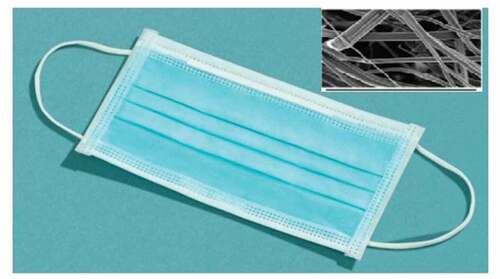
Knitted fabric structure
Knitted fabric is manufactured by the circular and flat knitting machine. The knitted fabric mask has been shown in (Lee et al. Citation2020). It may be further classified by weft and warp knitted structure. High extensibility is the added advantage of a knitted structure as compared with woven fabric and it is because of the interlocking loops of the yarn in the knitted structure. The weft and warp knitted structure are having high extensibility in the horizontal (weft) and vertical (warp) directions. The weft knitted fabric is produced by single yarn and warp knitted structure may require more than one yarn for forming the required structure. Knitted fabric structure has good breathability and air permeability as compared with woven structure (Russell Citation2006). The knitted structure is also having a potential application in implantable textiles including vascular grafts and artificial organs (Albrecht and Fuchs Citation2006).
Coated fabrics
Capturing bacterias and viruses from the mask is not sufficient to stop the spreading of the infection. Other than this, it is also required to kill the captured microorganism. Apart from the above-mentioned mask fabric, there are various finishes (coatings) available that can be applied to the fibrous layers to give antibacterial and antiviral property (Seidi et al. Citation2021).
Other than this, the finishes are applied to give some other required properties like hydrophobicity, water breathability, soil release, flame retardancy, etc. To impart antibacterial or antiviral properties to the face mask, various metallic nano particles were applied and tested against different microorganisms. Nanomaterials including metal oxide are nanostructures, graphene, carbon nanotubes, and carbon quantum dots, as well as bio-nano particles such as chitosan, along with capped silver, graphene, gold, and silicon nanoparticle thought to play a key role in anti-viral coating development (Shirvanimoghaddam et al. Citation2021). Among all those mentioned above, silver nano particles are the most commonly used in the application whenever antibacterial activity is required. The silver nanoparticles with special surfactants were synthesized and applied to a surgical mask by impregnation that shows good antibacterial activity with broad number of microbial surrogates of SARS-CoV-2 (Valdez-Salas et al. Citation2021).
Pristine cellulose nonwovens (CNW) were prepared by wet-laid non-woven process from softwood pulp (20%) and lyocell fiber (80%). Oxidation of cellulose fabrics by 2,2,6,6-Tetramethylpiperidine 1-oxyl (TEMPO), creates COOH groups on the surface of the fabric. The subsequent conjugation of the oxidized fabric with antimicrobial agents (including neomycin and polyhexamethylene guanidine) generates modified fabrics with strong antimicrobial properties. Treated fabric exhibits a good virucidal rate (>99.14%), bactericidal filtration efficiency (99.51%), and excellent air permeability (>1111.5 mm.s−1). The research confirmed the alternative arrangement for replacing polypropylene non-woven fabric with a natural one (Deng et al. Citation2022 a).
Research work developed the biodegradable, antiviral, and antibacterial cellulose non-wovens (AVAB-CNWs) by grafting guanidine-based polymer and neomycin sulfate on the fabric surface. Application of suitable grafted components and pre-treatments improves the hydrophobicity (self-cleaning), anti-viral, and anti-bacterial activities. The experimental results showed the high virucidal activity (>99.35%) for the natural non-woven treated fabric (Deng et al. Citation2022b).
Nano particle finish
In one of the study, a mixture of silver nitrate and titanium dioxide in the form of nano particles were applied to the surgical mask and were found to give the required antibacterial activity as per AATCC 100–1999 (Li et al. Citation2006). Similarly, various nano particles viz. Ag, ZnO, TiO2, etc. were used in the application of surgical masks for the protection against bacterial infection (Selvam et al. Citation2012). In one of the application, the nylon fabric is first treated with plasma chitosan and followed by the impregnation with silver nano particle (Botelho et al. Citation2021).
Hamouda et al. (Citation2022) investigated the effect of silver nano particle coated cotton and polyester knitted fabrics combined with spandex yarns as antiviral cloth masks. They discovered that silver nanoparticles had excellent antiviral activity by penetrating the cell membrane of the virus and engaging with the viral genome to protect the cell from trying to replicate. Selvam and Nallathambi (Citation2015) studied the impact of silver nanoparticles on the bacterial filtration efficiency (BFE) of polyacrylonitrile (PAN) nano structures and discovered that the developed Ag nano particle incorporated PAN nano filters have 99% efficiency against the bacteria and good anti-bacterial activity, enhancing their potential use in a protective mask. The PAN templated composite nano fibrous membrane utilizing GO/AgNP was investigated by Sharma et al. (Citation2021). The disc diffusion assay showed bactericidal efficiency with a zone of inhibition, revealing that the created composite nano fibrous membrane might be exploited as a possible nano fibrous filter for atmospheric pollution and bacteria. Li et al. (Citation2006) investigated the antibacterial activity of nanoparticles using a facemask coated with a combination of silver nitrate and titanium dioxide nanoparticles, which protects against infectious agents and lowers the risk of transmission. The reduced grapheme oxide (rGO) Ag NPs embedded in cotton or silk fabrics reduced the survival of the Gram-positive bacterium Staphylococcus aureus by 78–99%, according to Bhattacharjee et al. (Citation2021). Hiragond et al. (Citation2018) found that the face mask fiber treated with 100 ppm colloidal Ag solution has the highest antibacterial activity against Escherichia coli bacteria. The use of metallic nano particles has some disadvantages and consequences with respect to the environment, which has to take care of while using the final application. On the other hand, the facemask is developed by depositing few layers of graphene on the non-woven mask to give hydrophobicity and reusability just by sunlight exposure (Zhong et al. Citation2020).
Green synthesized nano particle coating
The eco-friendly and safe nano coating can be applied in the form of green synthesized NPs. In one of the study, antibacterial properties on cotton fibers are introduced by loading with silver NPs synthesized from natural plant extracts (Mimusops elengi flower) as a reducing and capping agent. It is suggested to use the same approach for the surgical mask (Haroon et al. Citation2017). The extract from Mimusops elengi flower was used for the green synthesis of NPs in another work and it was found to be an effective biological tool for the biosynthesis of silver NPs. The results also showed its good antibacterial activity against various pathogenic bacteria (Jeyasundari et al. Citation2016). Licorice plant root extract was used to produce the nanofibrous membrane by electro-spinning process. The plant extract provides better anti-microbial properties because of the presence of glycyrrhetinic acid (GA) and glycyrrhizin (GL) chemical groups. SEM images confirmed 15–30 µm diameter nano fiber with random porosity and orientation, which may help to prevent the penetration and activity of virus. Good breathability was also confirmed by measuring the air flow rate (85 L/min.) (Chowdhury et al. Citation2021). Likewise, various plant extracts have been successfully synthesized and applied to the fabrics for better antimicrobial activity (Ullah et al. Citation2014).
Classification of Face Mask
The face mask may be categorized based on their manufacturing techniques like
Woven,
Knitted, and
Non-woven structures.
The woven structure is produced as an open structure by yarn interlacement and the knitted fabric is produced by inter looping of knitted yarn. Both fabrics offer a high level of air passage to the wearer.
The reusable masks made from cotton, gauze, silk, and muslin cloth or fabric can be defined as cloth masks and their usage was started in the 19th century for avoiding the spread of communicable diseases. Both woven and knitted face masks are classified as cloth masks, and may not provide sufficient protection against bacterial filtration. The efficacy of cloth mask was studied in the mid of 20th century during the Spanish enfluenza pandemic. But it has not been further analyzed seriously because of the entry of the disposable non-woven mask into the market during 1960 (Rossettie et al. Citation2020).
The non-woven fabric is another prominent candidate for a face mask that has been manufactured from various non-woven manufacturing processes. Spun bond and melt blown techniques are used to produce the face mask by non-woven fabric, which can offer high filtration efficiency as well as good breathability to users. The face mask is produced from the combination of SMS (Spun bond/Melt blown/Spun bond) fabrics which achieve good filtration efficiency and lead to the market for various kinds of filtration masks in the medical field as well as public uses in the pandemic situation. Surgical masks are manufactured by layering three or four layers of non-woven fabric on both sides of the mask, where two layers of effective filtering fabric are embedded together which are capable to filter out above 1 micron size particles. Surgical masks are commonly produced from polypropylene with the GSM (Grams per Square Meter) of 20–25 (Henneberry Citation2020; 3M Science Citation2020b).
The respirators are also produced from multiple layers of non-woven fabric similar to a surgical mask. But, the respirator is assembled with various levels of GSM and high-level particular filtration fabric in the tight fit condition on the wearer’s face. The outer layer of respirator consists of the non-woven fabric between 20 and 50 GSM. It is mainly to protect the wearer from own exhalation and external environment. The pre-filtration layer is placed with the range of 250 GSM dense fabric next to the outer layer and it is normally needled non-woven. This layer is normally processed through thermal bonding process and provides sufficient shape retention to the face mask. The innermost layer is formed with the high-efficiency electric melt blown or SMS fabric which decides the filtration efficacy of respirators (Henneberry Citation2020).
The high filtration efficiency can be possible to achieve by the performance of non-woven fibrous filter, where the fibers are arranged in a random manner by several layers of web with uniform arrangement. The space between the fibers is mainly filled with air and these air pockets supports to free breathing by wearer. Particulate matter is captured by the fiber web in the non-woven structure and it is occurred because of different mechanisms including interception, inertial impaction, gravitational settling, and electrostatic attraction. These possible mechanisms mainly influence the performance and efficacy of non-woven filters (3M Science Citation2020a). World Health Organization (WHO) has also advised to avoid the usage of cloth masks in any situation (World Health Organization (WHO) Citation2020a). There is evidence in the research work that a maximum of 95% to 99% aerosol particulate matter may be stopped from penetrating in respirators as compared with surgical masks where only 90% of particulate is prevented to enter (Oberg and Brosseau Citation2008).
Soerokromo, Retera, and Lankhorst (Citation2014) have confirmed better protection from respirator mask (N95) while examining the performance of respirators and surgical masks (9 MM). The research has been performed with three groups () (Soerokromo, Retera, and Lankhorst Citation2014) of health care parameters such as respirator wearers, surgical wearers, and control measures. The study confirmed the lower colonization with respirator wearers (2.8%) as compared with surgical mask wearer colonization (5.3%).
The data for confirming the usage of cloth masks in personal protective equipment for health care workers is very limited in the past research work. However, some of the researchers attempted to understand the filtration efficacy of three different types of cloth masks. They used the polluted particulate size from 30 nm to 2.5 micron with polystyrene latex (PSL) microsphere aerosols. The result has confirmed that the surgical mask achieved around 78–94% filtration efficiency against the particles as compared with cloth masks filtration efficiency (39–65%). The research output ensured good performance and efficiency for a disposable surgical mask as compared with a cloth mask, while exposing the particle size smaller than 2.5 micron (Shakya et al. Citation2017).
The researchers found that the latest SARS-CoV-2 virus is around ~60–140 nm in diameter and the highest aerosolized particle diameter range is 0.25–1.0 micron. Many studies suggested that N95 respirators are the better alternative for filtering out the small particles below 0.1 micron with 94% filtration efficiency and it supports the concern to overcome the above-mentioned small particle size particulates filtration such as SARS-CoV-2 virus (Campbell Citation2020; Gardner et al. Citation2013; Harnish et al. Citation2013).
The face masks have been classified into three categories as per international standard American Society for Testing and Materials (Citation2020a) based on the barrier properties of filtration face mask. It has been enlisted () as follows: (1) Level 1 (Low barrier), (2) Level 2 (Intermediate barrier), and (3) Level 3 (High barrier) (Oberg and Brosseau Citation2008); American Society for Testing and Materials (Citation2020b).
Table 1. Classification of face mask levels based on their properties (ASTM F 2100–20).
Level 1 (low barrier)
The level 1 mask is called a low barrier and it can be considered to be used for the routine life, where a wearer is not involved in the health care work. The level of filtration with this face mask is less than 95%. The flame resistance level is also considered to be class 1 and resistance to synthetic blood penetration is around 80 mm Hg (ASTM standard). This category of mask can be used while exposure is to the low-risk level aerosol and liquid circumstances.
Level 2 (intermediate barrier)
The level 2 mask is called as an intermediate barrier and it can be used for medium-level aerosol and liquid environments. An intermediate barrier has a filtration efficiency of ≥98% and flame resistance is around class 1. The resistance to synthetic blood penetration in the level 2 mask is expected to be around 120 mm Hg. The differential pressure level is <6.0 mm H2O/cm2 which can provide good breathability to the wearer. The surgical face mask that has been produced with three layers of spun bond or melt-blown fabric may be grouped as level 2.
Level 3 (high barrier)
The level 3 masks are required for high-barrier activities. It may be helpful to filter the particle and bacteria at ≥98% efficiency. The differential pressure (mm H2O/cm2) allowed in the level 3 mask is <6.0 and it may provide a high level of comfortable breathing to the wearer. As level 3 masks provide high resistance (160 mm Hg) to synthetic blood penetration compared with other level masks, it is highly preferred for surgical mask application. The level 3 mask or respirator may be produced from three layers of SMS fabrics, and it can cover the mouth and nose of the user tightly.
Comparison of Different Types of Masks and Respirators
explains the available face masks (except ordinary cloth mask) in the worldwide market used for medical purposes and it has been listed out as (Kumar et al. Citation2021; Robertson Citation2021),
Single use face mask,
Surgical mask, and
Respirator.
Table 2. Comparison of different type of masks available in the worldwide market.
It has also been further classified based on material standards in .
A photograph of an ordinary cloth mask is given in . It is commonly used by millions of people during the last pandemic. The cloth facemask is highly recommended in areas of widespread transmission where there is limited scope to implement the standard operating procedure (SOP) of Covid-19. It is also highly recommended to use the cloth facemask in the widespread transmission areas, where the 1 meter separation cannot be possible to achieve in public areas such as public buses, trains, workplaces, and shops. WHO also recommended the following guidelines for cleaning reusable cloth facemask that includes washing of fabric mask in soap or detergent with boiled water (80°C) every day at least once or boiling the facemask for 1 min with subsequent hot water, detergent, and room temperature water wash (WHO Citation2020b).
Characterization of Face Mask
The face mask is classified based on the characteristics of the face mask material. The characterization of medical textile products has been performed in accordance with American Society for Testing and Materials (Citation2020b). The following tests are usually adopted for face masks, 1. Particle filtration efficiency (PFE), 2. Bacterial filtration efficiency (BFE), 3. Differential pressure or breathability, 4. Fluid or splash resistance, and 5. Flammability test (Chellamani, Veerasubramanian, and Balaji Citation2013; Rossettie et al. Citation2020).
Particle filtration efficiency (PFE)
The particle filtration efficiency (PFE) can help to assess the performance of respirator protection from particles. The experiment has been performed on Polyurethane latex sphere aerosols with a particle size of 0.1 µm at an airflow rate of 28 L/min. through the mask. PFE can be measured by calculating the difference between the amount of aerosol sphere passed through the fabric and the remaining residuals in the measuring container. The maximum and minimum PFE range is between 95% and 70%, respectively, for various classes of filtration masks. The PFE can be measured using standard protocol and calculated based on the aerosol particle concentrations downstream (Cdown) and upstream (Cup) of the sample holder that is used to hold face mask sample cut out from the full mask (Whyte et al. Citation2022).
Bacterial filtration efficiency (BFE)
The bacterial filtration efficiency (BFE) is the assessment of the particles’ filtration capability that has been expelled from the mask wearer. It is usually executed in face mask fabric with Staphylococcus aureus aerosols where a particle size is 3.0 µm at a flow rate of 28.3 L/min. Staphylococcus aureus is one of the leading nosocomial infection that originates from hospitals. Similar to PFE, the variation of aerosol concentration across both sides of the fabric is used to calculate the BFE of filtration masks. The expected level of BFE is between 95% and 98% for the face masks. Similar to the PFE, BFE can also be computed similar to equation 1. Also, based on the bacterial filtration efficiency test, the filtration efficiency was calculated as percentage difference between the control and test sample. The colony forming units (CFU) of the control (without sample) is C per ml and CFU of test sample is T per ml using the following equation (Selvam and Nallathambi Citation2015).
Differential pressure or breathing resistance
The breathing resistance is used to measure the airflow resistance of the facemask. A constant rate of airflow is required to be maintained for analyzing of the differential pressure of the sample. The result is derived by using the differential air pressure and surface area of the fabric. The high airflow resistance value indicates less breathability of the face mask wearer. It may be recommended that the low airflow resistance face mask is the better choice for comfortable breathing. The breathing resistance value allowed for face mask starts from ≤3.0 mm H2O/cm2 (non-splash-resistant surgical face masks) to ≤5.0 mm H2O/cm2 (splash-resistant surgical face masks) (Sundaramoorthy, Palanisawamy, and Jayaraman Citation2011). The differential pressure (ΔP) per cm2 of the tested specimen expressed in (Pa/cm2) of the tested fabrics was calculated based on the low side pressure (X1) and the high side pressure (X2) of the test specimen in Pa with the area (4.9 cm2) of the test specimen in cm2 as follows (Whyte et al. Citation2022)
Additionally, airflow rate (Q), air mean velocity (Um), and air permeability of the fabric (P) are also other important parameters for determining the functionality of the mask. The airflow rate in m3/s depends on the number of the pores (m), mask area (A) in m2, and air mean velocity in m/s. However, Um depends on the pressure drop across the face mask (ΔP) in Pa, hydraulic diameter of the mask pore (dp) in m, thickness of the fabric (h) in m, and air dynamic viscosity (η) in Pa.s. The air velocity (U) in m/s depends on porosity (ε) and Um (Hes and Dolezal Citation2017).
Fluid or splash resistance
Fluid or splash resistance examines the resistance of the face mask against the high-velocity streams of fluid at different velocity ranges. The validity of splash resistance was confirmed by using synthetic human blood at 80, 120, and 160 mm Hg blood pressure range, which helps to simulate the impact of human blood and other body secretion liquids on the face mask. The high splash resistance of the fabric can be ensured when the liquid penetration of fabric is stopped to appear on the front surface of the fabric from the backside.
Flame resistance
The flammability test can help to understand the flame resistance behavior of face masks and it may be an important parameter for the medical products that possibly and potentially ignite instruments in the operation theater. The flame resistance is the time required to spread the fire to a particular length of samples after igniting the fabric. The time length of flame spreading properties has been classified by many standards and research institutes. Mostly, it comes under four categories including classes 1–4, where class 1 indicates the least chance of flammable material. The face mask is recommended to prepare from class 1 and 2 material as per the United States Food and Drug Administration (FDA) direction.
Conclusion
Most health organizations have recommended using face mask in day-to-day life to avoid the communicable disease spreading. On the other hand, it is unavoidable to wear a personal protective kit with a face mask for health care and front runner worker to save their own life in the fieldwork. COVID-19 situation demands the use of face masks by everyone. Thus, this work made a detailed review to understand the different types of face masks available in the market including respirator, surgical mask, and cloth mask. The raw material requirements and manufacturing process of different kinds of face masks have been discussed and found that woven, non-woven, and knitted face masks are the most common. The importance of antiviral and antibacterial treatment on face masks has also been reviewed in detail which imparts special properties to the face mask due to the innovative use of nano-particle coatings and finishes. The classification of face mask based on the fabric structure and performance characteristics have been given which illustrates that main fabric structures could be woven, non-woven, and knitted which supports the filtration of objects by the fibrous network in ways like inertial impaction, interception, diffusion, and electrostatic deposition. Much of the research work has evidenced that the respirator is a better option to protect the wearer from bacterial and viral infections. The surgical face mask is also one of the alternative choices for health care workers during their routine activities. Higher breathability is also possible to achieve through cloth masks. However, there is no strong evidence to support the higher bacterial filtration efficacy of cloth masks. The fruitful research in the field of face masks is very important for safeguarding the health care workers and the public from the spreadable virus in the pandemic situation.
Highlights
Antiviral and antibacterial face mask used in pandemics are very importance.
Face mask history, importance, and classification are discussed.
Face mask material requirements, manufacturing techniques, and testing requirements have been deliberated.
Common fibers employed in face mask are reviewed.
Efficiency of face mask by several characteristics has been discussed.
Disclosure statement
No potential conflict of interest was reported by the author(s).
References
- 3M Science. 2020a. Respiratory protection for airborne exposures to biohazards. 3M. 2020. Available from: June 2020 (5):174: https://multimedia.3m.com/mws/media/409903O/respiratory-protection-against-biohazards.pdf
- 3M Science. 2020b. Respirators and surgical masks: A comparison. 3M. 2020. Available from: March 2020 (R 3): http://multimedia.3m.com/mws/media/957730O/respirators-and-surgical-masks-contrast-technical-bulletin.pdf
- Adanur, S. 2017. Wellington Sears handbook of industrial textiles. Pennsylvania, USA: Routledge.
- Albrecht, W., and H. Fuchs. 2006. Non-woven fabrics: Raw materials, manufacture, applications, characteristics, testing processes. W. Kittelmann, ed. Weinhim, Germany: John Wiley & Sons.
- American Society for Testing and Materials. 2020a. ASTM F2100-20: Standard specification for performance of materials used in medical face masks. New York, USA: ASTM International.
- American Society for Testing and Materials. 2020b. ASTM F2100-21, Standard Specification for Performance of Materials Used in Medical Face Masks. New York, USA: ASTM International.
- Belkin, N. L. 2009. The surgical mask has its first performance standard a century after it was introduced. Bulletin of the American College of Surgeons 94 (12):22–20.
- Bhattacharjee, S., R. Joshi, M. Yasir, A. Adhikari, A. A. Chughtai, D. Heslop, C. R. Macintyre, M. Willcox, and C. R. Macintyre. 2021. Graphene-and Nanoparticle-Embedded Antimicrobial and Biocompatible Cotton/Silk Fabrics for Protective Clothing. ACS Applied Bio Materials 4 (8):6175–85. doi:10.1021/acsabm.1c00508.
- Botelho, C. M., M. M. Fernandes, J. M. Souza, N. Dias, A. M. Sousa, J. A. Teixeira, A. Zille, and A. Zille. 2021. New textile for personal protective equipment—plasma chitosan/silver nanoparticles nylon fabric. Fibers 9 (1):3. doi:10.3390/fib9010003.
- Campbell, J. N95 vs FFP3 & FFP2 masks—what’s the difference? Fast Life Hacks. 2020 (No. 95). Accessed 3/26/2020. Available from: https://fastlifehacks.com.
- Chellamani, K. P., and S. Thiruppathi. 2009. Design and fabrication of a bacterial filtration efficiency tester. SITRA Research Report 54 (1):1À11.
- Chellamani, K. P., D. Veerasubramanian, and R. V. Balaji. 2013. Surgical face masks: Manufacturing methods and classification. Journal of Academia and Industrial Research 2 (6):320–24.
- Chowdhury, M. A., M. B. A. Shuvho, M. A. Shahid, A. K. M. M. Haque, M. A. Kashem, S. S. Lam, H. C. Ong, M. A. Uddin, and M. Mofijur. 2021. Prospect of biobased antiviral face mask to limit the coronavirus outbreak. Environmental Research 192:1–10. doi:10.1016/j.envres.2020.110294.
- Deng, C., F. Seidi, Q. Yong, X. Jin, C. Li, L. Zheng, Z. Yuan, and H. Xiao. 2022a. Virucidal and biodegradable specialty cellulose nonwovens as personal protective equipment against COVID-19 pandemic. Journal of Advanced Research 39:147–156. doi:10.1016/j.jare.2021.11.002.
- Deng, C., F. Seidi, Q. Yong, X. Jin, C. Li, X. Zhang, J. Han, Y. Liu, Y. Huang, H. Xiao, et al. 2022b. Antiviral/Antibacterial biodegradable cellulose nonwovens as environmentally friendly and bioprotective materials with potential to minimize microplastic pollution. Journal of Hazardous Material 424:1–11. doi:10.1016/j.jhazmat.2021.127391.
- Denton, M. J., and P. N. Daniels, ed. 2002. Textile Terms and Definitions. 11th Edn. Manchester, UK: The Textile Institute.
- Doust, B. C., and A. B. Lyon. 1918. Face masks in infections of the respiratory tract. JAMA: The Journal of the American Medical Association 71 (15):1216–19. doi:10.1001/jama.1918.26020410011008c.
- Ebuka, A. O., A. M. Zakey, and I. C. Escobar. 2021. Advanced Research and Development of Face Masks and Respirators Pre and Post the Coronavirus Disease 2019 (COVID-19) Pandemic: A Critical Review. Polymers 13 (12):1–47. doi:10.3390/polym13121998.
- Fennelly, K. P. 2020. Particle sizes of infectious aerosols: Implications for infection control. Lancet Respirateory Medicine 8 (9):914–24. doi:10.1016/S2213-2600(20)30323-4.
- Gardner, P. D., J. P. E. S. D. H. A. W. Richardson, K. C. Hofacre, A. W. Richardson, and K. C. Hofacre. 2013. Viable viral efficiency of N95 and P100 respirator filters at constant and cyclic flow. Journal of occupational and environmental hygiene 10 (10):564–72. doi:10.1080/15459624.2013.818228.
- Gayathri, P. U. K., S. Gayathri, D. V. Kirnab, S. M. Maliyekkal, and S. M. Maliyekkal. 2021. A comprehensive review on antimicrobial face masks: An emerging weapon in fighting pandemics.Royal. Society of Chemistry Advance 11 (12):6544–76. doi:10.1039/D0RA10009A.
- Hamouda, T., H. Kafafy, H. M. Mashaly, and N. M. Aly. 2021. Breathability performance of antiviral cloth masks treated with silver nanoparticles for protection against COVID-19. Journal of Industrial Textiles 51 (9):15280837211051100. doi:10.1177/15280837211051100.
- Harnish, D. A., B. K. Heimbuch, M. Husband, A. E. Lumley, K. Kinney, R. E. Shaffer, and J. D. Wander. 2013. Challenge of N95 filtering facepiece respirators with viable H1N1 influenza aerosols. Infection Control & Hospital Epidemiology 34 (5):494–99. doi:10.1086/670225.
- Haroon B.H., M. Kulandhaivel, S. Anbalagan, M. Sankareswaran, K. Abirami. 2017. Green Synthesis of Silver Nanoparticles using 002 Hybanthusenneaspermus Plant Extract against Nosocomial Pathogens with Nanofinished Antimicrobial Cotton Fabric. Global Journal of Nanomedicine 1 (1):555554. 2016. doi:10.19080/GJN.2017.01.555554.
- Hayavadana, J., and M. Vanitha. 2009. The world of surgical textiles surgical mask. Asian Textile Journal 18 (12):33–35.
- Henneberry, B. 2020. How surgical masks are made. New York, USA: Thomas Industry Update.
- Hes, L., and I. Dolezal. 2017. Testing of Air Permeability of Distant Knitted Fabrics in the Direction of their Plane. Journal of Textile Engineering and Fashion Technology 2 (6):547–49. doi:10.15406/jteft.2017.02.00083.
- Hiragond, C. B., A. S. Kshirsagar, V. V. Dhapte, T. Khanna, P. Joshi, and P. V. More. 2018. Enhanced anti-microbial response of commercial face mask using colloidal silver nanoparticles. Vacuum 156:475–82. doi:10.1016/j.vacuum.2018.08.007.
- Hofmeyr, G. J., J. P. Neilson, Z. Alfirevic, C. A. Crowther, A. M. Gülmezoglu, E. D. Hodnett, G. M. Gyte, and L. Duley. 2008. A Cochrane pocket book: Pregnancy and childbirth. Chichester West Sussex: Wiley.
- Hu, J. Y., Y. I. Li, and K. W. Yeung. 2006. Air permeability. In Clothing biosensory engineering, edited by Li Y, and Wong A.S.W., 252–60. Cambridge, England: Woodhead Publishing.
- Jeyasundari, J., P. S. Praba, Y. B. A. Jacob, S. Rajendran, and K. Kaleeswari. 2016. Green synthesis and characterization of silver nanoparticles using Mimusops elengi flower extract and its synergistic antimicrobial potential. American Chemical Science Journal 12 (3):1–11. doi:10.9734/ACSJ/2016/23161.
- Johnmin. 2022. Which Way Round Should a Surgical Face Mask Go? Accessed 2022-03-14 https://smartairfilters.com/en/blog/which-way-round-should-i-wear-my-surgical-face-mask/
- Kulichenko, A. V. 2005. Theoretical analysis, calculation, and prediction of the air permeability of textiles. Fibre Chemistry 37 (5):371–80. doi:10.1007/s10692-006-0011-6.
- Kumar, S., M. Karmacharya, S. R. Joshi, O. Gulenko, J. Park, G. -H. Kim, and Y. -K. Cho. 2021. Photoactive Antiviral Face Mask with Self-Sterilization and Reusability. Nano Letters Nano Letters 21 (1):337–43. doi:10.1021/acs.nanolett.0c03725.
- Lee, K. P., J. Yip, C. W. Kan, J. C. Chiou, and K. F. Yung. 2020. Reusable face masks as alternative for disposable medical masks: Factors that affect their wear-comfort. International Journal of Environmental Research and Public Health 17 (18):6623. doi:10.3390/ijerph17186623.
- Li, Y., P. Leung, L. Yao, Q. W. Song, and E. Newton. 2006. Antimicrobial effect of surgical masks coated with nanoparticles. The Journal of Hospital Infection 62 (1):58–63. doi:10.1016/j.jhin.2005.04.015.
- Mahadevan, M. G. 2009. Textile spinning, weaving and designing. Chandigarh, India: Abhishek Publications.
- Mark, J. E., ed. 1999. Polymer Data Handbook. New York, USA: Oxford University Press.
- McCarthy, B. J. ed. 2011. Textiles for hygiene and infection control. Cambridge, UK: Wood head Publishing Ltd.
- Needles, H. L. 1986. Textile fibers, dyes, finishes, and processes: A concise guide. New Jersy, USA: Noyes Publications.
- Oberg, T., and L. M. Brosseau. 2008. Surgical mask filter and fit performance. American Journal of Infection Control 36 (4):276–82. doi:10.1016/j.ajic.2007.07.008.
- Robertson, P. 2021. Accessed 2022-04-07 Comparison of Mask Ratings, Standards, and Filtration Effectiveness, https://smartairfilters.com/en/blog/comparison-mask-standards-rating-effectiveness/
- Rossettie, S. C., M. Perry, M. Pourghaed, and M. Zumwalt. 2020. Effectiveness of manufactured surgical masks, respirators, and home-made masks in prevention of respiratory infection due to airborne microorganisms. The Southwest Respiratory and Critical Care Chronicles 8 (34):11–26. doi:10.12746/swrccc.v8i34.675.
- Russell, S. J. 2006. Handbook of non-wovens. Oxford, UK: Wood head Publications.
- Schulman, J. S. 2020. Can Face Masks Protect You from the 2019 Coronavirus? What Types, Whenand How to Use, Accessed on June 2, 2020. https://www.healthline.com/health/coronavirus-mask
- Seidi, F., C. Deng, Y. Zhong, Y. Liu, Y. Huang, C. Li, and H. Xiao. 2021. Functionalized Masks: Powerful Materials against COVID‐19 and Future Pandemics. Small 17 (42):1–24. doi:10.1002/smll.202102453.
- Selvam, S., R. R. Gandhi, J. Suresh, S. Gowri, S. Ravikumar, and M. Sundrarajan. 2012. Antibacterial effect of novel systhesized sulfatedβ-cyclodextrin crosslinked cotton fabric and its improved antibacterial activities with ZnO, TiO2 and Ag nanoparticles coating. International Journal of Pharmaceutics 434 (1–2):366–74. doi:10.1016/j.ijpharm.2012.04.069.
- Selvam, A. K., and G. Nallathambi. 2015. Polyacrylonitrile/Silver nanoparticle electrospun nanocomposite matrix for bacterial filtration. Fibers and Polymers 16 (6):1327–35. doi:10.1007/s12221-015-1327-8.
- Shah, T. H., and A. Rawal. 2016. Textiles in filtration. In Handbook of Technical Textiles, 57–110. Cambridge, England: Woodhead Publishing.
- Shakya, K. M., A. Noyes, R. Kallin, and R. E. Peltier. 2017. Evaluating the efficacy of cloth facemasks in reducing particulate matter exposure. Journal of exposure science & environmental epidemiology 27 (3):352–57. doi:10.1038/jes.2016.42.
- Sharma, A., S. R. Kumar, V. K. Katiyar, and P. Gopinath. 2021. Graphene oxide/silver nanoparticle (GO/AgNP) impregnated polyacrylonitrile nanofibers for potential application in air filtration. Nano-Structures & Nano-Objects 26:100708. doi:10.1016/j.nanoso.2021.100708.
- Shirvanimoghaddam, K., M. K. Akbari, R. Yadav, A. K. Al-Tamimi, and M. Naebe. 2021. Fight against COVID-19: The case of antiviral surfaces. APL Materials 9 (3):031112. doi:10.1063/5.0043009.
- Soerokromo, N., L. Retera, and N. Lankhorst. 2014. Efficacy of face masks and respirators in preventing upper respiratory tract bacterial colonization and co-infection in hospital healthcare workers-Comment on the article by MacIntyre et al. Preventive medicine 65:153. doi:10.1016/j.ypmed.2014.04.020.
- Song, I. G., S. Mandal, and R. M. Rossi.2017. Thermal Protective Clothing for Firefighter,57-144.Woodhead Publishing
- Sotirio, P. 2020. COVID-19, Air Pollution and Global Disruption https://seetheair.wordpress.com/?s=corona+virus
- Spencer, D. J. 2001. Knitting Technology: A comprehensive handbook and practical guide, Vol. 16. Cambridge, England: Woodhead Publishing Limited.
- Sundaramoorthy, S., N. K. Palanisawamy, and S. Jayaraman. 2011. Air permeability of multilayer woven fabric systems. The Journal of the Textile Institute 102 (3):189–202. doi:10.1080/00405001003608147.
- Ullah, N., V. Yasin, Z. Abro, L. Liu, and Q. Wei. 2014. Mechanically robust and antimicrobial cotton fibers loaded with silver nanoparticles: Synthesized via Chinese holly plant leaves. International Journal of Textile Science 3:1–5.
- Valdez-Salas, B., E. Beltran-Partida, J. S. C. Nelson Cheng, E. A. Valdez-Salas, R. Curiel-Alvarez, M. Ibarra-Wiley, and R. Ibarra-Wiley. 2021. Promotion of surgical masks antimicrobial activity by disinfection and impregnation with disinfectant silver nanoparticles. 16:2689. doi:10.2147/IJN.S301212.
- Whyte, H. E., Y. Montigaud, E. Audoux, P. Verhoeven, A. Prier, L. Leclerc, G. Sarry, C. Laurent, L. L. Coq, A. Joubert, et al. 2022. Comparison of bacterial filtration efficiency vs. particle filtration efficiency to assess the performance of nonmedical face masks. Scientific Reports 12 (1). doi:10.1038/s41598-022-05245-4.
- Wilson, M. 2020. The untold origin story of the N95 mask. Fast Company. Available from: https://www.fastcompany.com/90479846/the-untold-origin-story-of-the-n95-mask
- Woodhead, K., E. W. Taylor, G. Bannister, T. Chesworth, P. Hoffman, and H. Humphreys. 2002. Behaviours and rituals in the operating theatre: A report from the Hospital Infection Society Working Party on Infection Control in Operating Theatres. The Journal of Hospital Infection 51 (4):241–55. doi:10.1053/jhin.2002.1220.
- World Health Organization (WHO). 2020a. Advice on the use of masks in the community, during home care and in health care settings in the context of the novel coronavirus, 2019-nCoV)outbreak: interim guidance, 29 January 2020 (No. WHO/nCov/IPC_Masks/2020.1. Geneva, Switzerland: World Health Organization.
- World Helath organization(WHO).2020 b. https://www.who.int/docs/default-source/coronaviruse/risk-comms-updates/update-30-use-of masks.pdf?sfvrsn=eeb24c14_2.
- Zhong, H., V. Zhu, J. Lin, C. F. Cheung, V. L. Lu, F. Yan, G. Li, and G. Li. 2020. Reusable and recyclable graphene masks with outstanding superhydrophobic and photothermal performances. ACS Nano 14 (5):6213–21. doi:10.1021/acsnano.0c02250.

